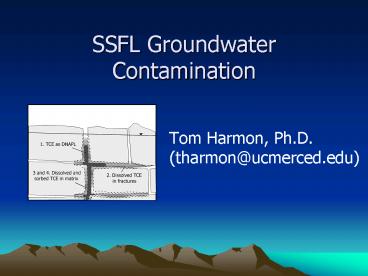SSFL Groundwater Contamination PowerPoint PPT Presentation
1 / 12
Title: SSFL Groundwater Contamination
1
SSFL Groundwater Contamination
- Tom Harmon, Ph.D. (tharmon_at_ucmerced.edu)
2
Overview
- Contamination of fractured groundwater systems by
solvents (TCE) - TCE amounts and extent at SSFL
- How much is there?
- How fast is it moving?
- How far will it go?
- Other contaminants
- Summary
3
groundwater monitoring data
- Review of monitoring reports
- trichloroethene or TCE (most data by far)
- horizontal TCE extent--how far?
- vertical TCE extent--how deep?
- other chlorinated compounds
- other contaminants (perchlorate, tritium,
radionuclides)
4
Offsite Wells or Springs
TCE 670ug/L 8/94 134XgtMCL
Vinyl Chloride 64 ug/L 3/94 32XgtMCL
Chloromethane 19ug/L 4/86 12XgtTWSL- Livestock
well
Benzene 3.8 ug/L 11/94 3.8XgtMCL
1,1-DCE 19ug/L 5/96 3XgtMCL
Trans-1,2-DCE 38ug/L 5/96 3XgtMCL
cis1,2-DCE 27ug/L 5/96 3XgtMCL
RD-56
RD-38
OS-5
RD-59
RD-32, RD-43
Carbon Tetrachloride 4.5ug/L 2/95 9XgtMCL
Outfall 002
Outfall 001
Manganese 390ug/L 3/94 7.8XgtMCL
Lead 50ug/L 12/94 4.2 Xgt MCL
Chromium 75ug/L 1/93 1.5 XgtMCL
Lead 40ug/L 1/95 3.3 XgtMCL
All above standards and backgrounds. Dates
range from 1992-94.
Not To Scale
5
Summary of off-site well observations
- Clearly multiple contaminants have migrated off
site and impacted off-site wells - Extremities of the plume appear to be defined
horizontally, but not as well-defined vertically - Horizontal migration appears to have halted
- TCE is clearly the most widespread contaminant
- Motivation to know how much TCE is in the ground
and in what physical form - undissolved liquid
- dissolved in water
- adsorbed to SSFL sandstone
6
What we usually think of when we say plumes
(contaminated bodies of groundwater)
flow
7
SSFL plumes differ from those in the previous
slide because they are in a fractured sandstone
system
DNAPL
8
What do we know about the amount of TCE in the
ground?
- We can very roughly calculate how of the TCE has
dissolved using the plume maps and a measure of
the TCE sorption to the SSFL sandstone - Many assumptions involved
- ellipsoid plume shapes (true shape irregular)
- 100 ft thickness (true thickness irregular and
unknown) - average concentrations assumed in different areas
- only one sorption measurement
- Result
100,000s gallons in dissolved from the original
TCE
9
Given this amount, the plumes are relatively
small, why?
- One hypothesis the TCE has been adsorbed by the
sandstone (like a giant sponge) - Another hypothesis only a very small portion of
the TCE has dissolved, and - ..the majority remains trapped in fractures
- many relatively shallow fractures (top 300 feet)
- some in relatively deep fractures (greater than
300 feet)
10
How much DNAPL or undissolved TCE remains is
difficult to estimate
11
Other groundwater contamination
- Perchlorate
- observed at several locations
- unlike TCE, no clear patterns in groundwater
- other chlorinated organics
- DCE isomers, vinyl chloride are transformation
products from TCE
12
Summary SSFL groundwater
- Clearly multiple contaminants (particularly TCE)
have migrated off site and impacted off-site
wells - Migration appears to have halted horizontally
- 100,000s gallons of TCE in SSFL subsurface
- may be stabilized by sandstone adsorption
- may have penetrated deeper and will appear in the
future - Other contaminants have been identified in SSFL
groundwater (perchlorate for example), but no
conclusive pathway to off-site locations has been
confirmed

